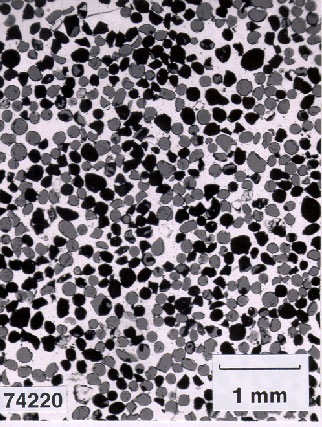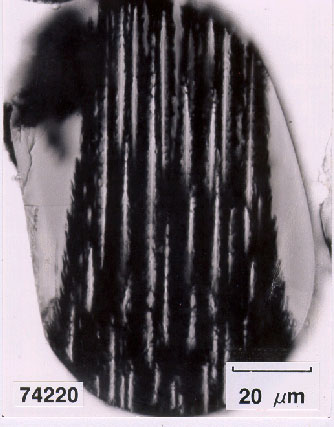
BRIEF DESCRIPTION OF 74220
| Lunar Sample Compendium Link | Lunar Sample Catalog Link | Open University Virtual Microscope Link |
Lunar sample 74220 was collected from an orange soil near a small crater at the Apollo 17 site. It is thought to be a sample of the "dark mantle" that covers a wide area around the Apollo 17 site. The sample is composed primarily of sma11 orange glass spheres, fragments of spheres, and black devitrified spheres (fig. 32). The sample also contains a small amount of admixed fragmental debris of mare basalts. This sample has been studied by Heiken et al. 1974 and Meyer et al. 1975. The glass composition is given in table 4 and figure 11. This glass is 3480 million years old (fig. 10).
Figure 32. Thin section photo of orange soil 74220. Spheroids of glass and devitrified glass (opaque) make up most of the sample. Sizes range from 40 to 80 microns.
Figure 33. Barred olivine chondrule from 74220. Olivine is coated with minute crystallites of opaque ilmenite.
Glass - The uniformly colored, homogeneous orange glass particles have spheroidal and oblate spheroidal shapes. Many of them are broken and/or devitrified. A small number of composite - glass particles have been reported. No vesicles or schlieren are present in the glass. Glass spheres range in size from a few microns to as large as 100 microns and commonly have a uniform size of about 40 to 60 microns. The grain size distribution of this soil is compared with other lunar soils in figure 55.
Olivine - Olivine needles originate at common nucleation centers on walls of the glass spheres. Barred olivine chondrules are also present (fig. 33). Occasional large subhedral olivine phenocrysts are found in a few spheres.
Opaques - Dendritic crystallites of ilmenite often form as parallel intergrowths with olivine or as minute submicroscopic crystallites coating olivine needles causing the devitrifidd glass to appear opaque (fig. 33).
Petrogenesis - It has been variously proposed that this glass could have originated by (1) endogenous lunar volcanism with associated lava fountaining, (2) an exogenic meteorite impact with associated vapor condensation to form the spheres, or (3) a meteorite impact into a liquid lava lake. Most lunar scientists now accept the lava fountain hypothesis, because trace element data do not support a meteorite origin. Composite glass particles formed by collisions in flight while the glass was still liquid (fig. 16). Volatile coatings (primarily ZnS) were found on the outer surfaces of the spheres by Meyer et al. 1975. Of course, no “Pele’s hair” is found on the Moon, because there was no atmospheric drag on the liquid glass droplets.


